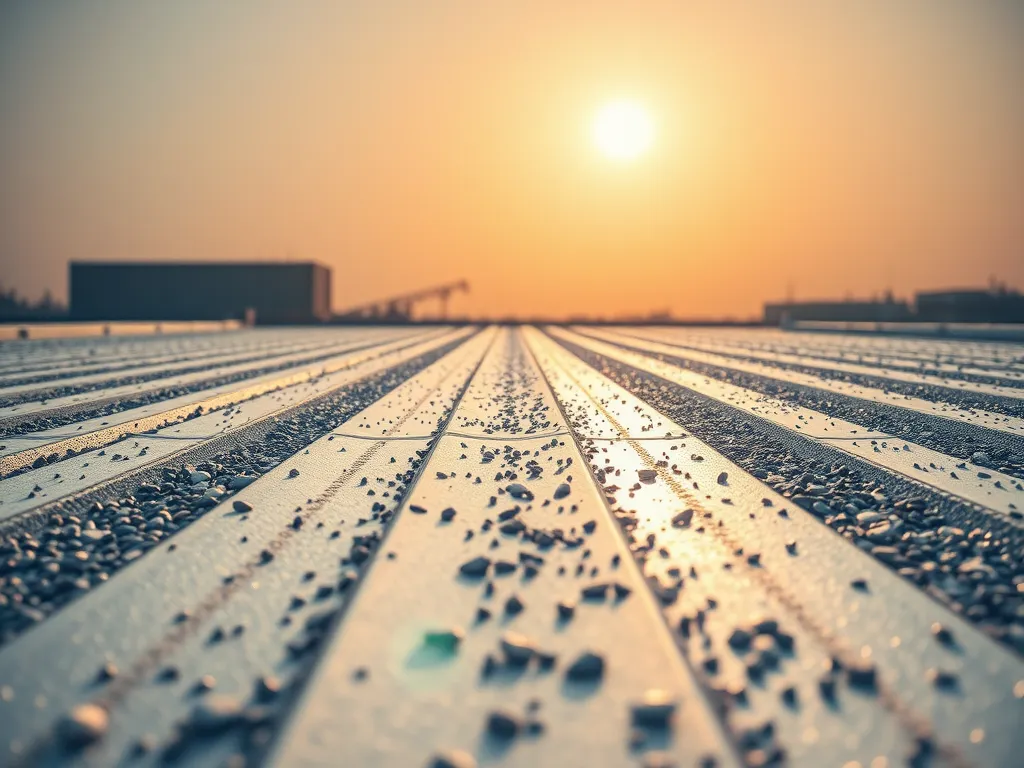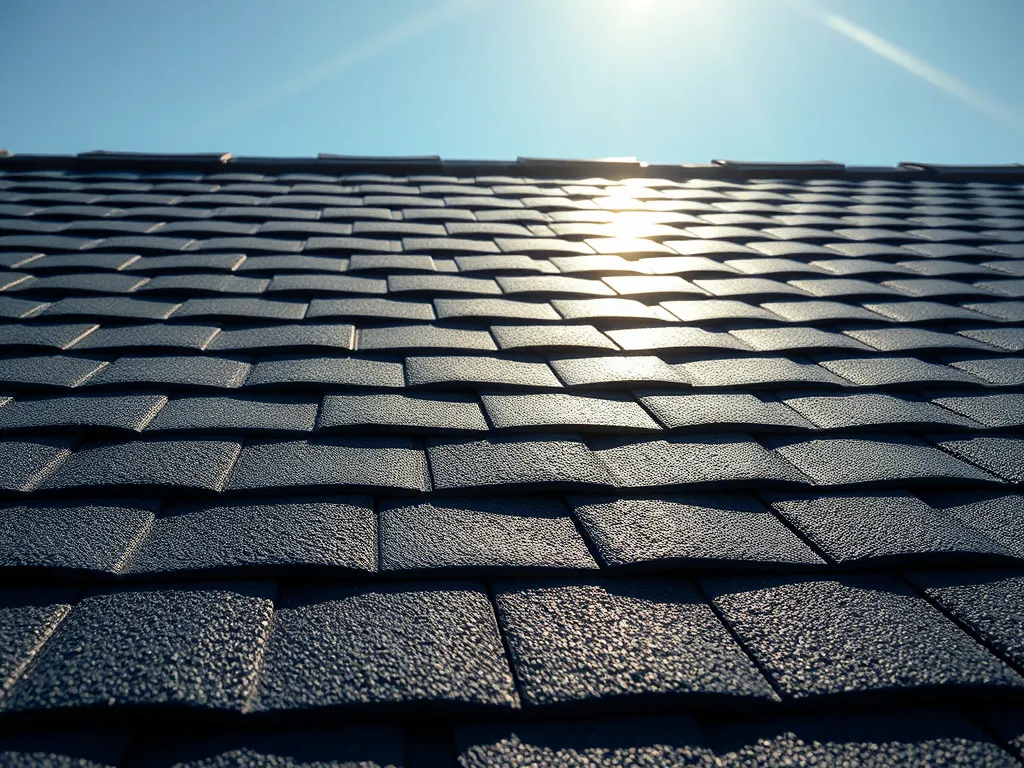Asphalt Shingles: 6 Reasons They Beat Metal, Tile & Slate Roofs
Published on: May 21, 2025 | Last Updated: April 14, 2025
Written By: George Voss
Asphalt shingles dominate 80% of U.S. residential roofs by offering unmatched affordability, durability, and style flexibility compared to metal, clay tile, or natural slate. These composite shingles layer fiberglass mats with asphalt and ceramic granules, creating waterproof barriers that withstand 110+ mph winds and Class 4 hail impacts at half the cost of premium materials—typically $3.50-$5.50 per square foot installed versus $10-$25 for metal or slate.
We analyze how asphalt shingles outperform competing roofing types through six proven advantages: budget-friendly pricing, 30-year lifespans rivaling pricier options, rapid installation with basic tools, low upkeep needs, customizable designs mimicking cedar shakes or European slate, and energy-saving reflective coatings. Direct comparisons against metal, wood, and tile roofs reveal why asphalt remains the practical choice for most homeowners.
Contents
What Are Asphalt Shingles?
Asphalt shingles consist of fiberglass mat coated with asphalt and mineral granules. Three layers work together: the fiberglass base adds strength, asphalt makes the surface waterproof, and granules shield against UV rays. This design creates roof coverings used on 80% of U.S. homes due to their balance of performance and cost.
Two primary types dominate the market:
- 3-Tab Shingles: Flat profiles with uniform cutouts, rated for wind speeds up to 60 mph
- Architectural Shingles: Dimensional layers that mimic wood or slate, withstand 130 mph winds
Luxury lines now replicate cedar shakes, slate tiles, or even solar panel layouts. Modern manufacturing adheres to ASTM D3462 standards for fire resistance (Class A rating) and granule adhesion. Their composition directly contributes to key benefits like weatherproofing, design versatility, and ease of handling during roof installations.
Now that we know their makeup, let’s explore how these features translate into practical benefits over metal, wood, and tile options.
Key Benefits Of Asphalt Shingles
Homeowners prioritize roofing materials offering reliability without compromise. Asphalt shingles deliver multiple strengths across cost, performance, and design.
Cost-effectiveness and Affordability
Balancing upfront costs with lasting value makes these shingles a practical choice. Installation typically runs $1.50–$5.50 per square foot, undercutting metal ($5–$12) or slate ($10–$20).
Lower Initial Investment Compared to Metal, Slate, or Tile
Material savings reach 50–70% versus premium options. Labor costs stay low due to simpler handling—no specialized tools or crews needed.
Long-Term Value and Budget-Friendly Repairs
Most repairs cost $150–$400, far below slate’s $1,000+ per incident. Warranties span 20–50 years, matching pricier alternatives.
Superior Durability and Weather Resistance
Modern shingles withstand nature’s extremes. Fiberglass bases resist cracking, while mineral granules shield against UV rays.
Protection Against Hail, Wind, and Extreme Temperatures
Class 4 impact ratings (UL 2218) handle 2″ hail. High-wind versions survive gusts up to 130 mph—outperforming wood shakes.
Lifespan Comparable to Many Premium Materials
Three-tab types last 20–25 years; architectural styles reach 30–50 years—rivaling metal roofs without their noise or denting issues.
Ease Of Installation
Lightweight construction speeds up projects. Roofers can lay 30–40 squares daily, versus 10–15 for slate.
Lightweight Design Simplifies Labor and Time
Weighing 225–400 lbs per square, they avoid structural upgrades needed for slate (800–1,500 lbs) or tile (600–1,200 lbs).
Compatibility with Most Roof Structures
Works on slopes from 2:12 to steep pitches. Flashing integrates seamlessly with chimneys, vents, or skylights.
Low Maintenance Requirements
Minimal care keeps roofs functional for decades. Yearly inspections plus debris removal suffice.
Minimal Upkeep Compared to Wood or Slate
No moss treatments or recoating like wood demands. Resists splitting better than brittle slate tiles.
Easy Replacement of Damaged Shingles
Lift tabs, remove nails, slide new units in. Full tear-offs aren’t needed for localized fixes.
Aesthetic Flexibility
Design versatility suits any architectural style. Over 50 color blends exist, from muted grays to bold terracottas.
Wide Variety of Styles, Colors, and Textures
Choose three-tab, architectural, or luxury profiles. Textured surfaces mimic wood grain, slate layers, or dimensional depth.
Mimics High-End Materials Like Cedar or Slate
Shadow lines on premium shingles replicate cedar’s ruggedness. Layered tabs imitate slate’s layered look at 30% of the cost.
Energy Efficiency
Reflective technologies cut cooling costs. Cool roof shingles meet ENERGY STAR® standards with solar reflectance over 25%.
Cool Roof Options for Reduced Heat Absorption
Special granules reflect UV rays, lowering roof temps by 20–40°F. Ideal for southern climates with intense sun exposure.
Lower Energy Bills Through Reflective Technologies
Studies show 10–15% reductions in summer cooling costs. Some utilities offer rebates for ENERGY STAR®-rated installations.
With these strengths established, evaluating how they stack up against metal, wood, or tile clarifies their leading role in roofing.

Asphalt Shingles Vs. Other Roofing Materials
Asphalt shingles lead the market for good reason. Let’s break down how they stack up against metal, wood, slate, and tile.
Compared to Metal Roofing: Cost and Noise Reduction
Metal roofs cost $9-$16 per square foot. Asphalt shingles? Just $4-$8. This gap makes asphalt a top pick for budget-focused jobs. Metal also amplifies noise during rain or hail. Asphalt’s fiberglass base absorbs sound, cutting indoor noise by up to 30%.
Compared to Wood Shakes: Fire Resistance and Maintenance
Wood shakes need yearly treatments to fight rot, bugs, and fire risks. Asphalt shingles come with Class A fire ratings (the highest grade) out of the box. No extra sprays or seals. Replace a damaged shingle in minutes—no sanding or staining required.
Compared to Slate or Tile: Weight and Installation Speed
Slate roofs weigh 800-1,500 lbs per square. Asphalt? Just 230-400 lbs. This light build lets crews install 3-5 squares per day vs. 1-2 for slate. No need for costly roof supports either.
While asphalt shines in these areas, its green perks also set it apart. Let’s explore how recycling and waste cuts boost its eco-edge.
Also See: Advancements in Asphalt Recycling Technology
Environmental Considerations
Asphalt shingles provide environmental perks that align with modern sustainability goals. These benefits make them a smart pick for homeowners weighing ecological impact alongside performance.
Recyclability Of Asphalt Shingles
Nearly 95% of asphalt shingles get recycled into new roads or roofing materials. Recycled Asphalt Shingles (RAS) mix crushed shingles with fresh asphalt binder, cutting material costs by 15-20% for road projects. Unlike slate or clay tiles, which often end up in landfills, asphalt shingles support circular economies. Over 11 million tons get repurposed annually in the U.S., reducing demand for virgin aggregates.
Reduced Waste During Production and Installation
Asphalt shingles generate up to 50% less jobsite waste than slate or wood shakes. Precision manufacturing ensures minimal scrap, with factory waste rates below 3%. Their lightweight design (200-350 lbs per square) eliminates the need for structural reinforcements, trimming material use by 30% compared to tile roofs. Installers also cut fewer shingles to fit angles, keeping landfill contributions low.
These eco-friendly features pair with practical benefits explored in common homeowner questions.

Frequently Asked Questions (FAQs)
Is Asphalt Shingles Better Than Metal Roofing?
Asphalt shingles typically offer a more cost-effective solution than metal roofing systems. They are also quieter during rainfall and hail, while providing comparable durability and longevity. Homeowners often favor asphalt due to its affordability and reduced noise levels, making it a popular choice for residential roofs.
Why Are Asphalt Shingles Still Widely Used Today?
The continued popularity of asphalt shingles can be attributed to their affordability, ease of installation, and variety of styles. They effectively meet the needs of many homeowners looking for reliable roofing solutions that balance performance and cost. Their ability to mimic high-end materials while remaining budget-friendly contributes significantly to their widespread use.
Are Asphalt Shingles Suitable for All Climates?
Yes, asphalt shingles are designed to perform well in a variety of climates. They offer good resistance to extreme temperatures, hail, and high winds, making them suitable for both hot and cold regions. Different styles and types of asphalt shingles are available to cater to specific weather conditions, enhancing their versatility across diverse environmental settings.
What is the Lifespan Of Asphalt Shingles Compared to Other Materials?
Asphalt shingles generally have life expectancies ranging from 20 to 50 years, depending on the type (three-tab or architectural). This lifespan rivals many premium materials, such as wood shakes and certain types of tile, providing homeowners with an attractive balance of initial cost and long-term investment potential.
How Do Asphalt Shingles Contribute to Energy Efficiency?
Asphalt shingles can improve energy efficiency through reflective technologies that reduce heat absorption. Cool roof options are available that comply with ENERGY STAR® standards, contributing to lower energy costs by keeping homes cooler during hot weather. This can result in significant savings on air conditioning bills during warmer months.

Closing Thoughts
Asphalt shingles present a compelling choice for homeowners seeking a reliable roofing solution. Their cost-effectiveness, superior durability, and ease of installation make them particularly attractive.
Their low maintenance needs and aesthetic flexibility further enhance their appeal, allowing homeowners to enjoy both function and style. With energy efficiency features, asphalt shingles also reduce costs in the long run, positively impacting monthly utility bills.
As we’ve discussed, these shingles outperform many alternatives such as metal, wood, and slate in multiple categories, presenting a well-rounded option for various climates and architectural styles.
For more detailed information and tools on asphalt shingles, visit Asphalt Calculator USA.
Additional Resources for You:
- Yoder, E. J., & Witczak, M. W. (1975). Principles of Pavement Design (2nd ed.). New York, NY: Wiley.
- What are the advantages and disadvantages of asphalt shingles as a roofing material? – Quora
- Asphalt Roof Shingles: A Good Investment? | Classic Roofing
- Asphalt Shingle Roofing – Important List of Pros and Cons
- Asphalt roofing shingles; advantages, materials and types


